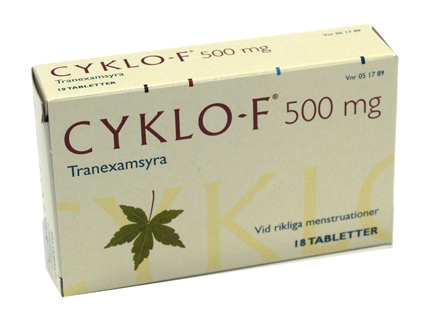

 Cyklo-F is the latest POM to P transfer, which has been launched amid controversy after it was announced the product would be available exclusively through Boots. Here, Alan Nathan gives you the facts you need to know about the medicine.
Cyklo-F is the latest POM to P transfer, which has been launched amid controversy after it was announced the product would be available exclusively through Boots. Here, Alan Nathan gives you the facts you need to know about the medicine.
What is Cyklo-F?
Tranexamic acid 500mg film-coated tablets. Each pack contains 18 tablets.
What is it licensed a P medicine for?
s
The reduction of heavy menstrual bleeding (menorrhagia) over several cycles in women with regular, 21-35 day cycles, with no more than three days of individual variability in cycle duration.
What is meant by “heavy menstrual bleeding”?
Menorrhagia has been defined as menstrual blood loss exceeding 80ml per cycle. Approximately 10 per cent of women of reproductive age have blood loss exceeding 80ml and 5-15 per cent of women are thought to be affected to such a degree that treatment should be considered. However, in practice menorrhagia is generally self diagnosed through a woman’s subjective assessment of blood loss.
How does it work?
The fibrinolytic system contributes to the prevention of blood clots through conversion of an inactive plasma enzyme, plasminogen, to plasmin, which has a fibrinolytic action. Women with menorrhagia have been found to have increased levels of plasminogen activators in the endometrium of the uterus compared with women with normal blood loss. Tranexamic acid is an antifibrinolytic agent that competitively inhibits the activation of plasminogen to plasmin. It therefore has an antifibrinolytic effect, but it is not thrombogenic. As a POM, it is also indicated for preventing blood loss during surgical procedures.
What is the dosage?
Two tablets three times daily for as long as is needed, for a maximum of four days. The dosage may be increased if there is very heavy menstrual bleeding, but a total dose of 4g daily should not be exceeded. Treatment should not be initiated until menstrual bleeding has started. Patients should consult their doctor if menstrual bleeding is not reduced after three menstrual cycles.
How safe is it?
Tranexamic acid has been in use as a POM for over 40 years (in the UK since 1983) and has been available without prescription in Sweden since 1997; treatment for menorrhagia with the drug corresponds to 3.2 million patient-years, and a further 15 million patients have been treated for other indications. The risk of thromboembolic events in women taking the drug is considered to be no higher than that in fertile women generally. There is no evidence that tranexamic acid increases the risk of thrombosis in women taking hormonal contraceptives.
What are the side-effects?
Common side-effects (more than 1 in 100 patients, less than 1 in 10 patients):
• Nausea
• Diarrhoea
• Vomiting
Uncommon side-effects (more than 1 in 1,000 patients, less than 1 in 100 patients)
• Allergic skin reactions
Are there any interactions with other drugs?
Cyklo-F will counteract the thrombolytic effect of fibrinolytic preparations.
What are the contraindications?
• Mild to moderate renal insufficiency
• Hypersensitivity to tranexamic acid or any of the excipients
• Active thromboembolic disease, a previous thromboembolic event or a family history of thrombophilia
• Haematuria
• Irregular menstrual bleeding, patients using warfarin or other anticoagulants
• Women taking oral contraceptives.
Who should consult their doctor before taking Cyklo-F?
Women who meet any of the following criteria should consult a doctor before taking Cyklo-F:
• Older than 45 years
• Obese
• Diabetic
• Has polycystic ovary syndrome
• Has a history of endometrial cancer in a first-degree relative
• Is receiving unopposed oestrogen or tamoxifen.
Which symptoms prompt a pharmacist to refer a patient requesting Cyklo-F to her GP?
• Irregular periods
• Bleeding between periods
• Bleeding after the menopause
• Pain during intercourse
• Bleeding after intercourse
• Premenstrual pain
• Pelvic pain
• Symptoms of thrombosis – pains or feelings of heaviness in the chest, unusual pains or swellings in the arms or legs; sudden shortness of breath; fainting; haemoptysis.
What serious conditions can be associated with menorrhagia?
• Endometrial cancer
• Ovarian cancer
• Endometriosis
• Fibroids
• Chronic pelvic inflammatory disease
• Thyroid disorders
• Blood clotting abnormalities.
Can Cyklo-F be taken while breastfeeding?
The concentration of tranexamic that passes into breast milk is around 1 per cent the concentration in the mother’s blood. An antifibrinolytic effect in the infant is unlikely, but nevertheless breastfeeding women should consult their GP before taking the drug.
How much does Cyklo-F cost?
The recommended retail price is £8.99 for a pack of 18 tablets.
When is Cyklo-F available?
It will be launched on January 31 2011.
When will pharmacies get supplies?
Cyklo-F will be available initially only from Boots stores as the company has an exclusivity arrangement with the product’s manufacturer, Meda Pharmaceuticals. Concerns have been expressed by some pharmacy organisations over the deal.

